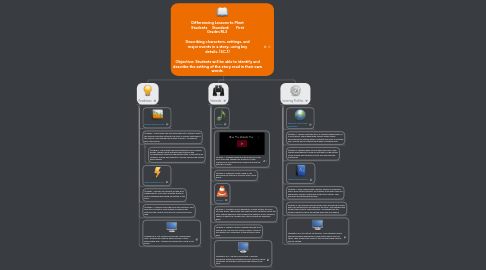Differencing Lessons to Meet Students Standard: First Grade~RL3 Describing characters, settings, and major events in a story, using key details. (SC,1) Objective: Students will be able to identify and describe the setting of the story read in their own words.
par Steph Dowtin

1. Readiness
1.1. BELOW GRADE LEVEL
1.2. Strategy 1: The teacher can read aloud the text to student. While the teacher reads the setting of the story is verbally identified by the teacher. Then teacher ask student to write 1-2 sentences about the setting.
1.2.1. Strategy 2: The teacher can guide students in small reading groups. Teacher assist with decoding of words and comprehension leading to the identification of the setting by students. Teacher ask students to verbally identify the setting while reading.
1.3. ABOVE GRADE LEVEL
1.4. Strategy 1: Teacher ask students to read story independently. Once story read the students write a paragraph describing the setting of the story.
1.5. Strategy 2: Students reads the story with a partner. Then pairs will complete a Venn diagram comparing the setting of the current story read to one previous story read.
1.6. Integration of 21st Century Technology: Above grade level~Students will read the eBook version of story. Below grade level~ Teacher will display story using Smart Board.
2. Interests
2.1. MUSIC
2.2. Strategy 1: Students watch a musical version of the story they read. Teacher ask students to draw illustration of the setting then verbally describe the setting to teacher.
2.3. Strategy 2: Students create a song or rap describing the setting of the story with a small group.
2.4. SPORTS
2.5. Strategy 1: "Answer & Score Basketball" Teacher divides the class into two teams. The teacher then asks the class a question about the story setting whichever team answers the question first is allowed a chance to shoot the "Answer Ball" into the miniature basketball hoop.
2.6. Strategy 2: Teacher creates a baseball themed story setting map. The map will outline 4 bases. Students will identify one component of the setting on each base.
2.7. Integration of 21 Century Technology: Using the interactive whiteboard students will play a musical game created by the teacher surrounding the setting of the story.
3. Learning Profiles
3.1. ENGLISH LANGUAGE LEARNERS
3.2. Strategy 1: Teacher reads the story to student independently or in small group. While reading the teacher draws visuals representing the setting within a concept map such as a bubble map. Teacher ask for student input while completing map.
3.3. Strategy 2: Teacher reads aloud to the entire class. Then teacher ask students to draw an illustration of the setting. Finally teacher has students present and describe their illustrations.
3.4. LEARNING DISABILITY
3.5. Strategy 1: While reading with a partner student is presented with a story setting checklist. As students reads they check off and identify various components of the story setting. Then discusses the setting with partner.
3.6. Strategy 2: The teacher reads aloud the story presenting students with cues pertaining to the setting of the story. Then teacher give student extra time to reread the story. The teacher ask the student questions about the setting while they are reading.
3.7. Integration of 21st century Technology: Have students record themselves while reading story using mobile device such as tablet. Then students will listen to their recording and verbally identify setting.


